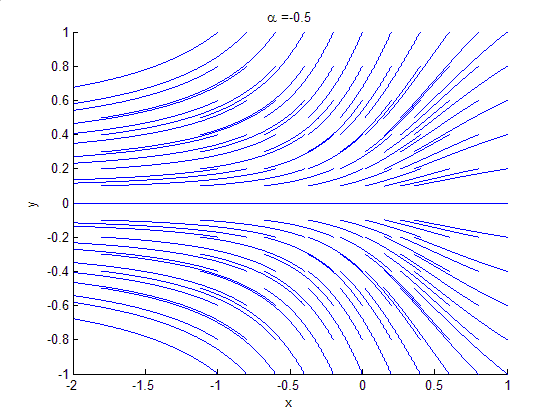|
Lyapunov–Schmidt Reduction
In mathematics, the Lyapunov–Schmidt reduction or Lyapunov–Schmidt construction is used to study solutions to nonlinear equations in the case when the implicit function theorem does not work. It permits the reduction of infinite-dimensional equations in Banach spaces to finite-dimensional equations. It is named after Aleksandr Lyapunov and Erhard Schmidt. Problem setup Let : f(x,\lambda)=0 \, be the given nonlinear equation, X,\Lambda, and Y are Banach spaces (\Lambda is the parameter space). f(x,\lambda) is the C^p -map from a neighborhood of some point (x_0,\lambda_0)\in X\times \Lambda to Y and the equation is satisfied at this point : f(x_0,\lambda_0)=0. For the case when the linear operator f_x(x,\lambda) is invertible, the implicit function theorem assures that there exists a solution x(\lambda) satisfying the equation f(x(\lambda),\lambda)=0 at least locally close to \lambda_0 . In the opposite case, when the linear operator f_x(x,\lambda) ... [...More Info...] [...Related Items...] OR: [Wikipedia] [Google] [Baidu] |
Aleksandr Lyapunov
Aleksandr Mikhailovich Lyapunov (russian: Алекса́ндр Миха́йлович Ляпуно́в, ; – 3 November 1918) was a Russian mathematician, mechanician and physicist. His surname is variously romanized as Ljapunov, Liapunov, Liapounoff or Ljapunow. He was the son of the astronomer Mikhail Lyapunov and the brother of the pianist and composer Sergei Lyapunov. Lyapunov is known for his development of the stability theory of a dynamical system, as well as for his many contributions to mathematical physics and probability theory. Biography Early life Lyapunov was born in Yaroslavl, Russian Empire. His father Mikhail Vasilyevich Lyapunov (1820–1868) was an astronomer employed by the Demidov Lyceum. His brother, Sergei Lyapunov, was a gifted composer and pianist. In 1863, M. V. Lyapunov retired from his scientific career and relocated his family to his wife's estate at Bolobonov, in the Simbirsk province (now Ulyanovsk Oblast). After the death of his father in 18 ... [...More Info...] [...Related Items...] OR: [Wikipedia] [Google] [Baidu] |
Erhard Schmidt
Erhard Schmidt (13 January 1876 – 6 December 1959) was a Baltic German mathematician whose work significantly influenced the direction of mathematics in the twentieth century. Schmidt was born in Tartu (german: link=no, Dorpat), in the Governorate of Livonia (now Estonia). Mathematics His advisor was David Hilbert and he was awarded his doctorate from University of Göttingen in 1905. His doctoral dissertation was entitled ''Entwickelung willkürlicher Funktionen nach Systemen vorgeschriebener'' and was a work on integral equations. Together with David Hilbert he made important contributions to functional analysis. Ernst Zermelo credited conversations with Schmidt for the idea and method for his classic 1904 proof of the Well-ordering theorem from an "Axiom of choice", which has become an integral part of modern set theory. After the war, in 1948, Schmidt founded and became the first editor-in-chief of the journal ''Mathematische Nachrichten''. National Socialism During ... [...More Info...] [...Related Items...] OR: [Wikipedia] [Google] [Baidu] |
Banach Space
In mathematics, more specifically in functional analysis, a Banach space (pronounced ) is a complete normed vector space. Thus, a Banach space is a vector space with a metric that allows the computation of vector length and distance between vectors and is complete in the sense that a Cauchy sequence of vectors always converges to a well-defined limit that is within the space. Banach spaces are named after the Polish mathematician Stefan Banach, who introduced this concept and studied it systematically in 1920–1922 along with Hans Hahn and Eduard Helly. Maurice René Fréchet was the first to use the term "Banach space" and Banach in turn then coined the term "Fréchet space." Banach spaces originally grew out of the study of function spaces by Hilbert, Fréchet, and Riesz earlier in the century. Banach spaces play a central role in functional analysis. In other areas of analysis, the spaces under study are often Banach spaces. Definition A Banach space is a complete norme ... [...More Info...] [...Related Items...] OR: [Wikipedia] [Google] [Baidu] |
Fredholm Operator
In mathematics, Fredholm operators are certain operators that arise in the Fredholm theory of integral equations. They are named in honour of Erik Ivar Fredholm. By definition, a Fredholm operator is a bounded linear operator ''T'' : ''X'' → ''Y'' between two Banach spaces with finite-dimensional kernel \ker T and finite-dimensional (algebraic) cokernel \mathrm\,T = Y/\mathrm\,T, and with closed range \mathrm\,T. The last condition is actually redundant. The '' index'' of a Fredholm operator is the integer : \mathrm\,T := \dim \ker T - \mathrm\,\mathrm\,T or in other words, : \mathrm\,T := \dim \ker T - \mathrm\,\mathrm\,T. Properties Intuitively, Fredholm operators are those operators that are invertible "if finite-dimensional effects are ignored." The formally correct statement follows. A bounded operator ''T'' : ''X'' → ''Y'' between Banach spaces ''X'' and ''Y'' is Fredholm if and only if it is invertible modulo compact ... [...More Info...] [...Related Items...] OR: [Wikipedia] [Google] [Baidu] |
Range Of A Function
In mathematics, the range of a function may refer to either of two closely related concepts: * The codomain of the function * The image of the function Given two sets and , a binary relation between and is a (total) function (from to ) if for every in there is exactly one in such that relates to . The sets and are called domain and codomain of , respectively. The image of is then the subset of consisting of only those elements of such that there is at least one in with . Terminology As the term "range" can have different meanings, it is considered a good practice to define it the first time it is used in a textbook or article. Older books, when they use the word "range", tend to use it to mean what is now called the codomain. More modern books, if they use the word "range" at all, generally use it to mean what is now called the image. To avoid any confusion, a number of modern books don't use the word "range" at all. Elaboration and example Given a functi ... [...More Info...] [...Related Items...] OR: [Wikipedia] [Google] [Baidu] |
Co-dimension
In mathematics, codimension is a basic geometric idea that applies to subspaces in vector spaces, to submanifolds in manifolds, and suitable subsets of algebraic varieties. For affine and projective algebraic varieties, the codimension equals the height of the defining ideal. For this reason, the height of an ideal is often called its codimension. The dual concept is relative dimension. Definition Codimension is a ''relative'' concept: it is only defined for one object ''inside'' another. There is no “codimension of a vector space (in isolation)”, only the codimension of a vector ''sub''space. If ''W'' is a linear subspace of a finite-dimensional vector space ''V'', then the codimension of ''W'' in ''V'' is the difference between the dimensions: :\operatorname(W) = \dim(V) - \dim(W). It is the complement of the dimension of ''W,'' in that, with the dimension of ''W,'' it adds up to the dimension of the ambient space ''V:'' :\dim(W) + \operatorname(W) = \dim(V). Similarl ... [...More Info...] [...Related Items...] OR: [Wikipedia] [Google] [Baidu] |
Projection (linear Algebra)
In linear algebra and functional analysis, a projection is a linear transformation P from a vector space to itself (an endomorphism) such that P\circ P=P. That is, whenever P is applied twice to any vector, it gives the same result as if it were applied once (i.e. P is idempotent). It leaves its image unchanged. This definition of "projection" formalizes and generalizes the idea of graphical projection. One can also consider the effect of a projection on a geometrical object by examining the effect of the projection on points in the object. Definitions A projection on a vector space V is a linear operator P : V \to V such that P^2 = P. When V has an inner product and is complete (i.e. when V is a Hilbert space) the concept of orthogonality can be used. A projection P on a Hilbert space V is called an orthogonal projection if it satisfies \langle P \mathbf x, \mathbf y \rangle = \langle \mathbf x, P \mathbf y \rangle for all \mathbf x, \mathbf y \in V. A projection on a Hilbert ... [...More Info...] [...Related Items...] OR: [Wikipedia] [Google] [Baidu] |
Bifurcation Theory
Bifurcation theory is the mathematical study of changes in the qualitative or topological structure of a given family of curves, such as the integral curves of a family of vector fields, and the solutions of a family of differential equations. Most commonly applied to the mathematical study of dynamical systems, a bifurcation occurs when a small smooth change made to the parameter values (the bifurcation parameters) of a system causes a sudden 'qualitative' or topological change in its behavior. Bifurcations occur in both continuous systems (described by ordinary, delay or partial differential equations) and discrete systems (described by maps). The name "bifurcation" was first introduced by Henri Poincaré in 1885 in the first paper in mathematics showing such a behavior. Henri Poincaré also later named various types of stationary points and classified them . Bifurcation types It is useful to divide bifurcations into two principal classes: * Local bifurcations, which can b ... [...More Info...] [...Related Items...] OR: [Wikipedia] [Google] [Baidu] |
Perturbation Theory
In mathematics and applied mathematics, perturbation theory comprises methods for finding an approximate solution to a problem, by starting from the exact solution of a related, simpler problem. A critical feature of the technique is a middle step that breaks the problem into "solvable" and "perturbative" parts. In perturbation theory, the solution is expressed as a power series in a small parameter The first term is the known solution to the solvable problem. Successive terms in the series at higher powers of \varepsilon usually become smaller. An approximate 'perturbation solution' is obtained by truncating the series, usually by keeping only the first two terms, the solution to the known problem and the 'first order' perturbation correction. Perturbation theory is used in a wide range of fields, and reaches its most sophisticated and advanced forms in quantum field theory. Perturbation theory (quantum mechanics) describes the use of this method in quantum mechanics. The ... [...More Info...] [...Related Items...] OR: [Wikipedia] [Google] [Baidu] |
Regularization (mathematics)
In mathematics, statistics, finance, computer science, particularly in machine learning and inverse problems, regularization is a process that changes the result answer to be "simpler". It is often used to obtain results for ill-posed problems or to prevent overfitting. Although regularization procedures can be divided in many ways, following delineation is particularly helpful: * Explicit regularization is regularization whenever one explicitly adds a term to the optimization problem. These terms could be priors, penalties, or constraints. Explicit regularization is commonly employed with ill-posed optimization problems. The regularization term, or penalty, imposes a cost on the optimization function to make the optimal solution unique. * Implicit regularization is all other forms of regularization. This includes, for example, early stopping, using a robust loss function, and discarding outliers. Implicit regularization is essentially ubiquitous in modern machine learning appr ... [...More Info...] [...Related Items...] OR: [Wikipedia] [Google] [Baidu] |
Partial Differential Equation
In mathematics, a partial differential equation (PDE) is an equation which imposes relations between the various partial derivatives of a Multivariable calculus, multivariable function. The function is often thought of as an "unknown" to be solved for, similarly to how is thought of as an unknown number to be solved for in an algebraic equation like . However, it is usually impossible to write down explicit formulas for solutions of partial differential equations. There is, correspondingly, a vast amount of modern mathematical and scientific research on methods to Numerical methods for partial differential equations, numerically approximate solutions of certain partial differential equations using computers. Partial differential equations also occupy a large sector of pure mathematics, pure mathematical research, in which the usual questions are, broadly speaking, on the identification of general qualitative features of solutions of various partial differential equations, such a ... [...More Info...] [...Related Items...] OR: [Wikipedia] [Google] [Baidu] |



